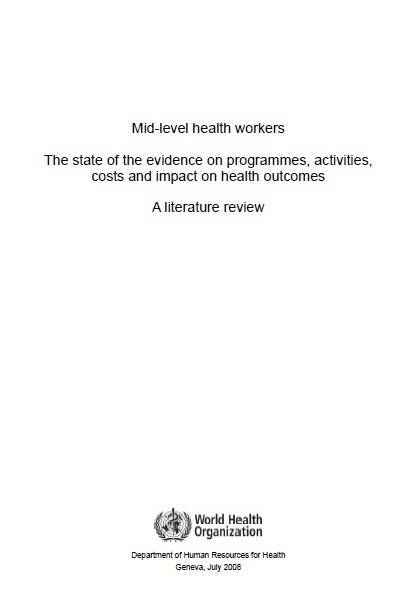Mid-level health workers: The state of the evidence on programmes, activities,costs and impact on health outcomes
A literature review

Overview
A severe and growing shortage of health workers has become an international emergency that in recent years has generated considerable international attention and concern. The crisis is greatest in low income countries with high disease burdens and health systems on the brink of collapse. One strategy identified to alleviate health worker shortages and improve access to and quality of health services has been the accelerated use of mid-level workers.
Mid-level workers are health care providers who have received less training and have a more restricted scope of practice than professionals; who, in contrast to community or lay health workers, however, do have a formal certificate and accreditation through their countries’ licensing bodies.
Mid-level practitioners have been used in many countries for more than 100 years. In many low income countries, mid-level doctors (then called auxiliaries) originated in colonial times, when they were trained to render care to indigenous populations as professional health care remained the privilege of Europeans. Today they are used in high- and low-income countries either to assist professionals or to render care independently, particularly in rural health centres and district hospitals, making up for the scarcity or absence of professionals such as therapists, doctors, dentists, pharmacists or nurses.
But despite their often vital importance to health service delivery, particularly in low-income countries, mid-level cadres are often considered a stopgap measure in emergency situations. They are consequently neither properly integrated into health systems nor adequately planned for and managed. If, however, they are considered key cadres to render health care in the short to medium term, but more likely in the long term as well, integration, planning and management of these cadres within health sector planning must be improved.
This review aims to support such efforts by collating what we know about experiences with mid-level cadres in low-income countries in Africa, south-east Asia and the Pacific, regions that heavily rely on them. It interrogates the existing evidence on the evaluation of different types of mid-level workers and their impact on health outcomes and it identifies knowledge gaps. The review focuses specifically on the role of mid-level workers as independent practitioners in areas that suffer from severe shortages of professionals. The review took a narrative and iterative approach to finding literature. It focused on English-language material published between 1963 and January 2008.
